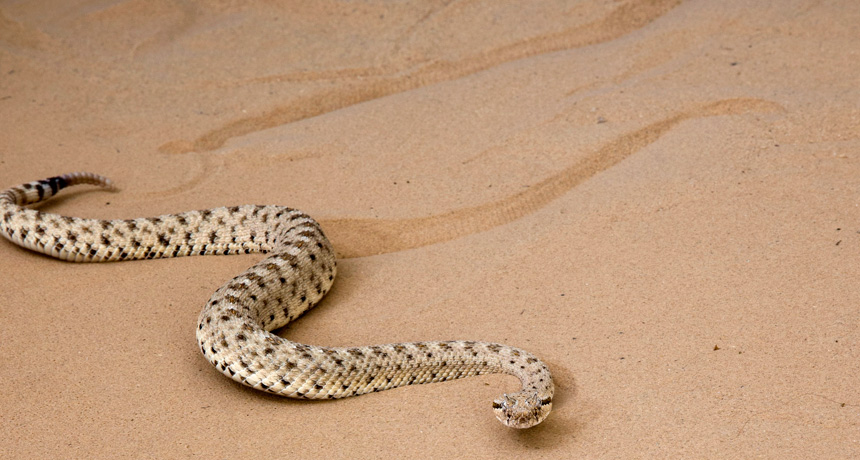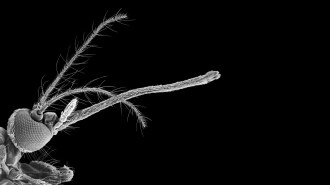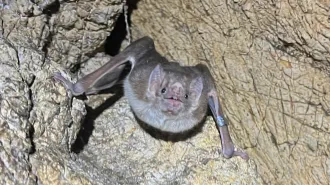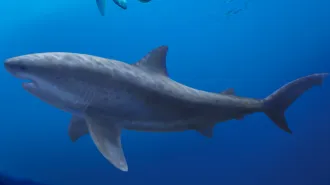Rattlesnakes tutor robot on dune climbing
Sidewinder snakes show roboticists a trick for climbing treacherous sand

SNAKES ON PLANES A sidewinder rattlesnake’s unusual skill in climbing sandy slopes inspired tweaks to long, skinny robots.
Adam Thompson
Sidewinder rattlesnakes wriggling up sand dunes turn out to have a trick of adjusting their curvy moves that’s improving robot design and the understanding of legless motion on sand.
In lab tests on sandy inclines, Crotalus cerastes snakes easily outslithered 13 other kinds of pit vipers and a robotic snake, says physicist Daniel Goldman of the Georgia Institute of Technology in Atlanta.
As a sidewinder slithers upward on increasingly steep slopes, it doesn’t press deeper and deeper as might be expected. Instead, sidewinders minimize their risk of slipping by increasing the proportion of their body in contact with the sandy surface on any particular wriggle, Goldman and his colleagues sayin the Oct. 10 Science. Increasing body contact might take less energy than gouging deeper into the sand, Goldman says.

Empowering robots to move up slippery, unstable sand could extend the reach of rescue efforts or just plain exploring, says study coauthor Howie Choset of Carnegie Mellon University in Pittsburgh. In 2011, one of his snake-shaped robots, named Elizabeth, joined an archaeological expedition to caves on Egypt’s Red Sea coast that hold remains of ancient Egyptian ships. Elizabeth wriggled into an unexplored cave but was foiled by a sandy incline it could not climb.
To see how sidewinders cope with sandy slopes, Goldman turned to Zoo Atlanta. Instead of bringing venomous animals into the lab, coauthor Hamidreza Marvi , then at Georgia Tech, built a sand-locomotion test slope in a shed at the zoo to film snakes climbing at angles. He constructed an air system to gust the particles on the slope back into a smooth-flowing mass after each snake had squiggled around and even brought in 200 kilograms of sand from rattlesnake territory in Arizona. On this high-tech dune, coauthor Joseph Mendelson of Georgia Tech and Zoo Atlanta led a team of handlers trying to coax snakes up slopes.
Of the species tested, only sidewinders use their signature very S-curvy motion to climb, increasing their body contact with the surface to almost half their length when slopes reached about 20 degrees. Twelve of the other 13 species failed to climb sandy inclines of even 10 degrees. They “just sort of flail around and do pitifully,” Goldman says. One other kind of rattlesnake worked its way awkwardly upward but it’s no sidewinder.
Analyzing video of the snakes inspired Goldman and his colleagues to distill the motion to a template, or a simplified concept that captures the essentials. He and his colleagues propose that sidewinding arises from the interplay of two wavelike snake motions, just a little out of phase in time, with one wriggling vertically and the other side to side.
“The idea of the template is a really profound way of thinking about all animal movements,” says Jake Socha of Virginia Tech in Blacksburg, who studies airborne snake motions. “Maybe flying snakes also need two offset waves of bending,” he says. “I think this will be useful for all types of research on locomotion in snakes.”
The insights from the test certainly helped the current version of the Elizabeth. Researchers tested their ideas about snake motion by adjusting the robot, which now does a passable upslope sidewind.
SIDEWINDING Sidewinder rattlesnakes demonstrate their S-curve moves in climbing sandy slopes that other species can’t. A snakelike robot uses a similar gait to conquer an incline. Credit: Maxwell Guberman, H. Marvi, Nico Zevallos and Chaohui Gong, Henry Astley; narrated and produced by Ashley Yeager







